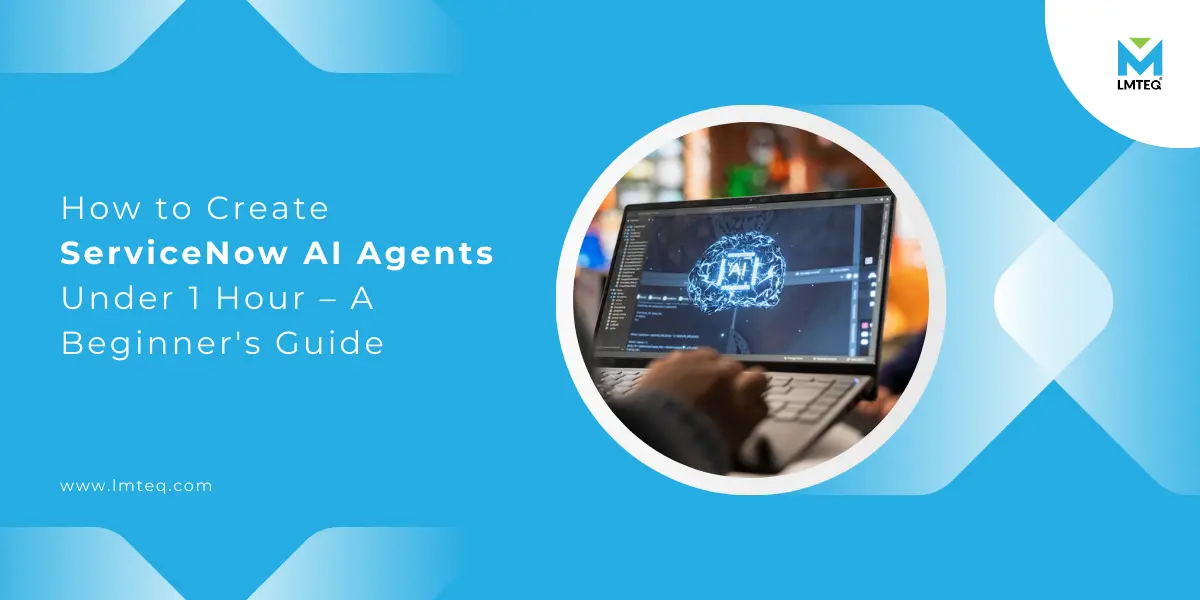Introduction
Did you know that over 60% of IT service desk tickets are repetitive, yet nearly 40% require reasoning beyond simple automation? [HDI Research] highlights how IT support teams struggle with balancing volume and complexity. This is where ServiceNow AI Agent Development steps in.
For many businesses, the hesitation with adopting AI in ServiceNow is clear: licensing costs are high, and the value must be proven with strong, real-world use cases. The good news? You don’t need to build a massive enterprise AI to demonstrate impact. With the right approach, you can create an AI Agent in ServiceNow that shows true intelligence, not just automation, in under 60 minutes.
In this guide, you’ll learn :-
- What makes a ServiceNow AI Agent different from scripts?
- A step-by-step process for ServiceNow Now Assist and ServiceNow Gen AI.
- A real-world use case: Incident Auto-Triage AI Agent.
- Extra scenarios you can try next.
- FAQs every beginner asks.
By the end, even if you’re a new developer, you’ll be confident in how to create an AI Agent in ServiceNow and test it with business-ready results.
What is a ServiceNow AI Agent?
Before we dive into the tutorial, let’s clarify what an AI Agent actually is.
An AI Agent in ServiceNow is more than a chatbot or flow. It uses ServiceNow Agentic AI capabilities, powered by ServiceNow Now Assist and ServiceNow Gen AI, to reason, decide, and act using multiple steps. Instead of running a fixed script, the AI Agent evaluates the problem, chooses which AI Orchestrator ServiceNow tool to use, executes actions, and adapts based on outcomes.
Think of it this way :-
- Automation = a train on fixed tracks. It runs the same way every time.
- AI Agent = a driver with a GPS. It decides the best route based on traffic, roadblocks, and conditions.
This difference is why ServiceNow AI Agent Development is so powerful. It enables reasoning-driven outcomes in IT, HR, customer service, and finance.
Step-by-Step Guide – Building an Incident Auto-Triage AI Agent
Now let’s get practical. We’ll walk through creating an Incident Auto-Triage AI Agent — a use case that proves AI value beyond scripts. The agent will :-
- Receive a new incident.
- Analyze the description.
- Search for related knowledge articles.
- Resolve the incident automatically if a solution exists.
- Escalate to L2 support if not.
This whole process, if followed step by step, can be set up in under an hour by a new ServiceNow developer.
Step 1 :- Prerequisites
Before you start, ensure you have :-
- Plugins installed: AI Agent Studio, Now Assist, Generative AI Controller.
- Role access: sn_aia.admin (for AI Agent Studio).
- Grounding data: A few knowledge base (KB) articles about common IT issues like VPN login, password reset, or email access.
- Privacy setup: Enable Data Privacy for Now Assist so no sensitive fields are exposed to external models.
Quick Tip :- Don’t skip privacy! Enterprises trust ServiceNow AI Agent Use Case implementations because data masking is built in.
Step 2 :- Create a New AI Agent
- Navigate to AI Agent Studio → Agents → New.
- Name: Incident Auto-Triage Agent.
- Description: “This agent analyzes incoming IT incidents, suggests solutions, and resolves or escalates automatically.”
- Assign it to the ITSM application scope.
You’ve now created the container for your agent.
Step 3 :- Define the Agent’s Brain (Prompt + Guardrails)
In the agent configuration :-
- Prompt Instructions :- “You are an IT service desk assistant. For every incident, analyze the description. If a knowledge article matches, resolve the ticket and notify the user. If not, escalate to L2 support.”
- Guardrails :-
- Maximum reasoning steps: 5
- Do not store or reveal personal data
- Always prefer the knowledge base over escalation
Quick Note :- Writing a strong prompt is one of the most underrated parts of ServiceNow Developer Guide AI setups.
Step 4 :- Attach Tools (The Agent’s Hands)
An AI Agent is only as strong as the tools you give it. Attach these skills :-
- Search KB (Flow Designer action)
- Resolve Incident (custom subflow to close ticket + update work notes)
- Escalate to L2 (assign group = IT L2, add comment)
- Notify User (send email or Teams message)
You’ve now given your agent “hands” to act.
Step 5: Connect Generative AI Reasoning
- Go to Generative AI Controller.
- Add your LLM provider (Azure OpenAI or ServiceNow’s partner model).
- Select a capability config: Q&A + reasoning.
- Link it to the AI Agent created earlier.
Now your agent can think, not just follow.
Step 6: Create the Agentic Workflow
- Navigate to AI Agent Studio → Agentic Workflows → New.
- Trigger: “New Incident created.”
- Flow logic :-
- Receive incident → Agent interprets description.
- If the KB article is found → Resolve.
- If not → Escalate.
- Save and publish.
This workflow ensures the AI Agent orchestrates steps dynamically.
Step 7: Test the AI Agent
- Open Agent Studio Test Console.
- Input test scenario: “User reports VPN not working.”
- Watch the reasoning path :-
- Finds KB article → applies fix → resolves.
- Try a second case: “Email server down.”
- No KB found → Escalates.
Quick Tip :- Run at least 10 varied test cases. Note how often it resolves correctly vs escalates.
Step 8: Pilot & Deploy
- Deploy to a limited group (like IT service desk L1).
- Collect KPIs for one week :-
- % incidents resolved by AI Agent
- Avg. resolution time
- Escalation accuracy
- Adjust tools, KB quality, and prompts as needed.
With this, you’ve successfully built your first ServiceNow AI Agent Use Case, a reasoning-powered assistant that shows ROI.
Disclaimer :- These steps are meant to help beginners understand how to start creating simple ServiceNow AI Agents. Depending on the complexity of the use case and the actions involved, the steps, configuration details, and scope may vary. Always review your organization’s governance, security, and compliance requirements before moving an AI Agent to production.
Some Use Cases to Try
Each case is beginner-friendly but demonstrates why AI > automation.
| Use Case | Business Value | Complexity | Example Outcome |
|---|---|---|---|
| IT Incident Auto-Triage | Faster MTTR | Medium | 40% incidents resolved without human effort |
| HR Onboarding Assistant | Better employee experience | Low | 70% onboarding questions answered instantly |
| Procurement Auto-Approval | Policy compliance | Medium | Approves requests under $1,000 automatically |
| Customer Service Triage | Improved CX | High | Routes cases to correct queues instantly |
Each case is beginner-friendly but demonstrates why AI > automation.
Benefits of ServiceNow AI Agents
From a Business Perspective :-
- Faster ROI on Licensing – AI Agents demonstrate clear value by resolving real issues, justifying the cost of ServiceNow Gen AI.
- Improved Customer & Employee Experience – End users get faster resolutions and smarter responses, improving satisfaction scores.
- Cost Savings – Reduces dependency on human L1 agents for repetitive tickets, lowering operational costs.
- Scalability – One AI Agent can handle thousands of interactions simultaneously, without additional staffing.
- Competitive Edge – Businesses can showcase intelligent IT and service operations as part of their digital transformation strategy.
From an Operations Perspective :-
- Reduced Ticket Volume – AI Agents resolve repetitive queries, freeing staff for higher-value tasks.
- Consistency in Resolutions – Standardized answers via ServiceNow Now Assist ensure compliance and accuracy.
- Enhanced Productivity – IT and HR teams spend less time on repetitive work, improving throughput.
- Better Insights – AI Orchestrator ServiceNow logs every decision, giving teams data on what can be automated further.
- Continuous Learning – As knowledge bases grow, AI Agents become smarter without heavy re-development.
Quick Note :- The real win is that these benefits come from reasoning, not just running a pre-built script. That’s the value of ServiceNow Agentic AI.
FAQs on ServiceNow AI Agents
1. How to create an AI Agent in ServiceNow if I’m new?
Start with AI Agent Studio → Create Agent → Add tools → Configure prompts → Test with sample cases. Even as a beginner, you can build a working agent in under an hour.
2. Is ServiceNow Gen AI secure for enterprise data?
Yes. ServiceNow integrates Data Privacy for Now Assist to mask sensitive data before sending to external LLM providers, ensuring enterprise-grade compliance.
3. What’s the difference between ServiceNow AI Agent and scripted automation?
Automation runs fixed workflows. An AI Agent, powered by AI Orchestrator ServiceNow, reasons dynamically, chooses tools, adapts to inputs, and provides real intelligence.
Conclusion
Building your first AI Agent may sound intimidating, but as you’ve seen, it’s approachable even for beginners. With ServiceNow AI Agent Development, you can create reasoning-driven workflows that show ROI quickly. Starting with an Incident Auto-Triage Agent, you’ve learned how to :-
- Set up an AI Agent in ServiceNow Now Assist.
- Configure tools, prompts, and guardrails.
- Test and deploy with real-world impact.
This is just the beginning. AI Agents can transform IT, HR, customer service, and procurement, anywhere reasoning matters more than scripts.
LMTEQ is a Preferred Consulting and Implementation Partner specializing in AI solutions on ServiceNow. If your business wants to explore agentic AI, reach out to us today and unlock real value.

